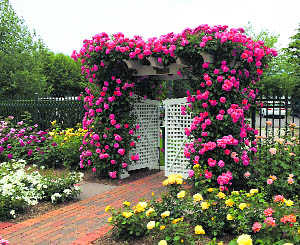Amarjeet Singh Batth
What will you visualise when asked to imagine a rose plant in a garden? For most of you the image will be of a rose-bed full of small bushes laden with flowers of different colours. This no doubt is the most common perception about roses and very rarely does one picture roses climbing wildly over the boundary walls or house walls making a lavish spread of foliage and flowers. But, roses growing vertically can create an equally mesmerising effect.
Technically, climbing roses are not a particular variety of rose but any variety can be trained to ‘climb’ in an orderly manner.
It has been observed that roses bloom more profusely laterally than when grown vertically. Rosa Indica and Rosa multiflora are commonly trained as climbing rose.
Rambling roses are among the ancestors of climbing roses. The main difference between rambling roses and climbing roses is that the former usually flower once, whereas climbing roses have repeat flowering with some exceptions.
Climbing roses are ideal for limited flat space as these use more of vertical space than horizontal one.
Light and location
The most favorable time to plant roses is pre-winters in October-November so that the plant develops a sturdy root system and establishes itself before the winter sets in. Roses require ample morning sun light from east. Therefore, plant them at a such a location which receives at least six hours of sunlight.
Avoid cramped and damp locations and choose a spot that has adequate space for the plant to flourish as climbing roses tend to spread more.
If the roses are planted to cover the wall plant then at least 12” away from the walls. Climbers that climb the wall and trellis can be planted at three feet while those planted along the wall should be planted at a distance of 8 ft.
Roses need light and a nutrient rich soil. They are heavy feeders and require more fertilisers because of their vigorous growth and size. Roses, like many other plants, do well in well-drained soil so ensure proper drainage.
While planting rose plants one has to be careful about the soil health also. In beds that already had some rose plants, it is best to replace the soil. This is necessary to save your new plants from the diseases and pests afflicting the old plants. Replace a minimum of 6 inches of soil and mix two third part of well-rotten compost to the new soil and allow it to settle for 1-2 weeks.
Climbing roses are often planted as bare root plants without any container or ball of soil. Dig a hole about twice as wide and deep as the potting plant root size. Add bone meal and other nutrients at the base of the hole and mix them in the soil. Settle the plant root in the hole and carefully spread the roots. Fill the hole with the compost mixture and gradually press the soil layer by layer so that there are no air pockets . But don’t press very hard as this can damage the roots.
Irrigate the plant thereafter and maintain the moisture.
Allow breathing space
The rose root stock grows vigorously and climbs over the arches, pergolas and gazebos and looks majestic. Climbing roses are used for making fencing and covering the boundary walls providing greenery, colour and security. Horizontal wires near the walls should be put up to allow air circulation for the branches.
When rose bush is used to cover the walls of building, it is advised to place the trellis away from the wall for air circulation and up keep. Climbing roses tend to get heavy and need a sturdy support structure to hold a fully grown plant.
Pruning and training
Rose pruning makes the plants grow well in a given direction. If this is not carried out carefully then the branches will become a tangled mess with few flowers.
Climbing roses produce two kinds of shoots — the main structural and the flowering shoot which grows from main shoot. The long structural branches are tied into the support structure. It is better to erect the support before the roses are planted.
Allow the plant to grow un-pruned for some time ( say year or two). Only remove dead and broken branches during this time.
Once the plant is established remove the unwanted and overcrowded canes to streamline the plant in the desired form.
Unlock Exclusive Insights with The Tribune Premium
Take your experience further with Premium access.
Thought-provoking Opinions, Expert Analysis, In-depth Insights and other Member Only Benefits
Already a Member? Sign In Now










